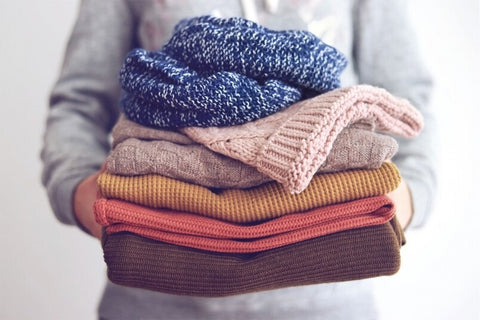I wonder if everyone will care about the fabric composition of the clothes when they buy clothes, and will they carefully look at the washing label sewn into the clothes? Only by knowing the composition of the fabric, it is convenient to wash and care for the clothes and prolong the service life of the clothes. According to the respective characteristics of clothing fabrics, different washing protection methods are adopted. To this end, the following 10 common clothing fabrics are selected to tell.
Cotton

When wearing clothes made of pure cotton, avoid prolonged exposure to the sun. Washing immediately after sweating can reduce the appearance of fading or discoloration of clothing. Note that light and dark clothes are washed separately. When washing, it is best to wash on the reverse side, and it needs to be hand washed at 30 degrees water temperature, dried in the shade or flat, because machine washing or dry cleaning will cause more or less damage to the fabric. However, in the rainy season, cotton clothes can never be dried in the sun, so the importance of the dryer can be reflected at this time.
Polyester

Polyester has good wrinkle resistance and shape retention, high strength and elastic recovery ability, strong and durable, wear-resistant, non-iron, non-sticky. Many good advantages make it machine washable, hand washable, dry cleanable, lightly rubbed and washed, not twisted, should be dried in the shade, and can be washed with various laundry detergents and soaps. The only caveat is that polyester is so sensitive to heat that the washing temperature should be kept below 45 degrees Celsius.
Spandex

High elasticity is the most important feature of spandex, so it is widely used in clothing fabrics, underwear, socks, swimwear, sports legging, intimate clothing, headbands, these elastic clothing have more or less spandex composition . Have you ever found that you have never seen a fabric with only spandex, because spandex cannot be woven alone, and is generally woven with other raw materials. The proportion of spandex is about 3%-10%, and the proportion of spandex in swimwear fabrics can reach 20%. Spandex has good alkali resistance and heat resistance, can be used with various detergents, and can be hand washed and machine washed.
Hemp cloth

Hemp cloth is a kind of fabric made of flax, ramie, jute, sisal, abaca and other hemp plant fibers. It is generally used to make casual wear and work wear, and currently it is mostly used to make ordinary summer wear. Hemp fabrics are also objects that require good care. Avoid sun exposure and fading, be gentle when hand washing, avoid brushing or rubbing, so as to prevent the fabric from fluffing. Colored hemp fabrics should not be soaked in hot water. They can be ironed when the clothes are almost dry. It is not advisable to press and iron the folds heavily to avoid brittleness.
Silk

Silk is a general term for various silk fabrics woven from silk as raw material. Although it is not easy to take care of, it is very light and dry, comfortable and breathable, and it is also one of the best in terms of skin-friendly properties. Can be used to make all kinds of clothing, especially suitable for women's clothing. Silk is relatively expensive in the market, and careful care is naturally essential. Silk is not resistant to salt water and should be washed frequently, especially after sweating. When washing, it is necessary to add special detergent in cold water, and use gentle methods. Do not expose to the sun or dry it, otherwise it will easily turn yellow or become brittle. It should be placed in a ventilated and cool place to dry.
Rayon

Rayon clothes have a bright luster and a slightly rough feel. They are easy to shrink after washing and should be washed with cold water to avoid deformation. Do not twist hard when washing, so as not to break the fibers; dry it in a cool place, and do not expose it to the sun.
Modal Fabric

Modal itself has good softness and excellent hygroscopicity, but lacks stiffness, so it is mostly used in the production of underwear or other intimate clothing. Wearing modal in summer has an inexplicable cool feeling, more comfortable and breathable than cotton, and more sweat-absorbing. Modal is best washed by hand, gently scrub with neutral laundry detergent or soap, do not use a washing machine, and do not soak in water that is too hot. Modal feels comfortable and comfortable to wear, but it will be easily deformed if you don't pay attention to the washing method, and the shrinkage rate is very high, so it should not be soaked for a long time.
Wool

Wool fabrics are slender, light, soft, slippery and warm, and are generally used in cashmere sweaters, winter coats, or scarves and hats. Soft and elastic to the touch, crisp, pure color, soft and natural luster, no wrinkle after hand grip, slight creases will recede in a short time and restore to be flat. For wool clothes, dry cleaning or hand washing is preferred. When hand washing, the water temperature should not exceed 30 °C. It is recommended not to use washing powder or chlorine-containing bleaching agent. You can choose a special detergent for wool sweaters and mix them with warm water. Rinse with clean water, and dehydrate for 1-2 minutes. If it is machine washed, it must be carried out according to the washing steps of the wool sweater on the washing machine, and the water temperature should also be controlled within 30 ℃.
Faux fur

Faux fur is a plush-shaped fabric that looks like animal fur. It feels thick, soft and warm. Soak in cold water for 30 minutes before cleaning, and use a soft brush or hand to gently rub. After washing, drying is also a lot of attention. When hanging clothes, pay attention to placing them in a ventilated place, or drip dry them naturally. Do not wring them out or spin them in the washing machine, which will damage the fabrics, and they should not be placed in direct sunlight. It is to dry with a hair dryer or the like. Be careful not to put the heat source directly on the clothes. You can cover it with a layer of cloth to avoid damage to the clothes. And it is best not to iron the collar of the clothes after washing, so as not to deform.
Denim

When it comes to denim fabrics, everyone should be very familiar with them. Now many garments are made of denim fabrics. The denim clothing has a good style and is loved by many people. There are four washing methods for denim: normal wash, stone wash, enzyme wash and rinse. Under normal circumstances, soaking in salt water for a period of time before washing will not fade, try not to use detergent, because detergent will speed up the color fading. After all, the texture and thickness of denim are different, and the cleaning options are various. In order to ensure the quality of denim, the cleaning method should also be well selected.
I hope this popular science article can help you realize the difference between different fabrics, so that you can take good care of your clothes!









